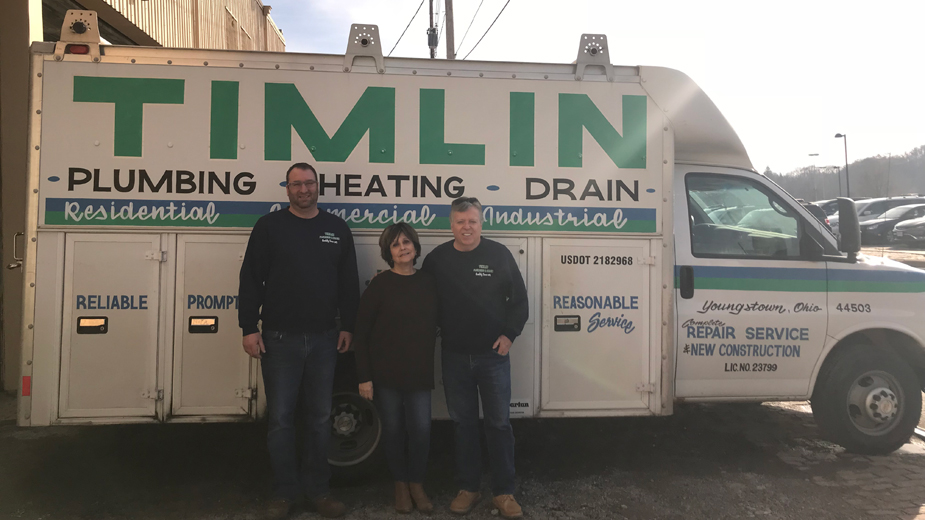Plenty of Jobs in the Pipelines for Plumbers
YOUNGSTOWN, Ohio – The pipes that transport fresh water into, and waste out of, a home are taken for granted. Until something goes wrong.
“Everything’s an emergency to everyone in that moment,” Russ Jakovina says. “There was a house in Boardman that flooded out the first floor and blew the back wall out. That was a nightmare.”
Jakovina, a dispatcher, estimator and job coordinator at Timlin Plumbing & Drain Services in Youngstown, is the first person upset people talk to when they call his company about an emergency.
Much of Timlin Plumbing’s business is repair work for the residential and commercial sectors, which means a lot of the calls are emergency calls. “People will go on vacation and not shut their water off and something will blow when they’re gone. Water control in your house can cause a lot of damage,” he says. “And there’s always somebody with a gas leak.”
“We do about 2,500 repair calls a year and a lot of them are similar, but really every one is a little different,” says Mike Timlin, president of Timlin Plumbing.
“The difference between the commercial world and the residential world is distinctive,” he continues. “A lot of our commercial customers are used to having things go wrong because it’s part of staying in business. So they handle situations a lot more calmly than somebody whose water heater breaks and there’s water all over the basement.”
Plumbers whose business is mostly in repair work, such as those who work for A to Z Plumbing and Drain Services in Niles and Timlin, are trained to handle these situations. Repairs are typically made within a day.
“Service is where we put all of our time, effort and resources. We gear up all of the trucks for repairs to be done the same day,” says A to Z’s president, Brian Pritchard. The company does residential and commercial plumbing work: cleaning drains, pumping septic tanks, one-day bath solutions, excavation, relining pipes and water conditioning.
A water heater might break once in a person’s lifetime. On the other hand, in the commercial sector the No. 1 call that A to Z receives relates to a line break. “Everything inside of a restaurant can break when it comes to plumbing and it happens often,” Pritchard says. “Whether it’s the grease trap, drains or faucets.”
Others in the industry, such as Local 396 of the Plumbers & Pipefitters union in Boardman, send the majority of its members to the more time consuming assignments in the industrial sector.
“We do a little bit of everything from residential service work to Dairy Queen and Dunkin’ Donuts, all the way through hotels and the heavy industrial sites of the coke battery [ArcelorMittal mill] in Warren, into heavy power plant sites,” says Marty Loney, business agent for Local 396.
The union consists of 500 plumbers, pipefitters, welders, refrigerator, heating and air conditioning mechanics, and another 170 retirees.
Its biggest project is the $900 million Lordstown Energy Center. Union members are installing piping at the site to bring in natural gas that will be converted to electricity. The pipe is made of carbon steel, stainless steel, plastics and chrome.
“Some types of material take temperature or pressure better, so that would be a reason why it’s a mix of different things,” Loney says. “Typically you wouldn’t see a lot of those things on the more commercial sites. But this one is a heavy industrial site so you’re going to get into a little bit of everything.”
Residential and commercial sites are usually much simpler when it comes to materials used. Over the years, plumbers have seen a change from water lines consisting of copper piping to PEX piping, or cross-linked polyethylene, and plastics because PEX and plastic cost less.
“We still always recommend copper,” Timlin says. “Copper has been around since [before] World War II and has stood the test of time. The new stuff that’s out there is really good and has gotten better over the years. It’s just that there isn’t a history yet.”
Methods of joining pipe have evolved to offer more options as well. “Before on a heating system, you would see that it was mostly welded,” Loney explains. “Now there’s grooved joints that come out called a mechanical joint. And there’s other ways of joining copper now for water lines and things that are called a pressed joint.”
The number of manufacturers in the plumbing industry similarly has grown as more brands begin to make their own products. “If you buy their pipe, you also have to buy their fittings and tools to work on the piping,” Timlin points out.
It’s important for plumbers to have a good relationship with their manufacturers should a problem arise. The plumbing company can then call to inform the manufacturer there’s a problem, find out if it has happened before, and whether the plumber can get a replacement for his customer at no additional charge. Many manufacturers are offering extended or lifetime warranties for their products, Pritchard says, which makes it easier on the customer.
Other changes include more customers wanting to buy their own materials at big-box stores, such as Home Depot, Lowe’s and Menards, for the plumbers to use, and more people going the do-it-yourself route to repair their own plumbing problems.
“With computers, people are more aware of what needs done and what’s available,” Timlin says. “But we work with it.”
“Amazon has made everything so instant. Everybody is used to instant gratification for everything,” Pritchard adds. “People have less time to mess around with a backed-up drain or a leaky toilet.”
Pictured: Russ Jakovina, Fran and Mike Timlin say employees of Timlin Plumbing & Drain Services make 2,500 repair calls a year.
Copyright 2024 The Business Journal, Youngstown, Ohio.


